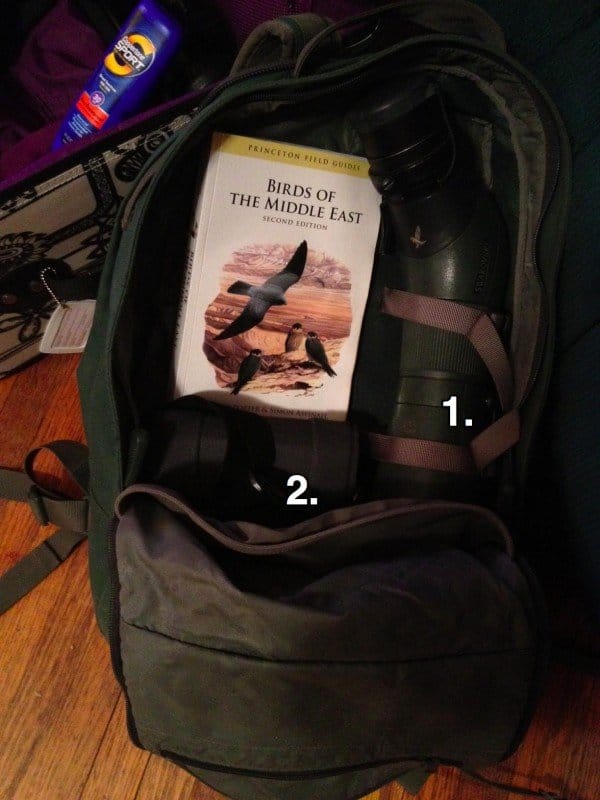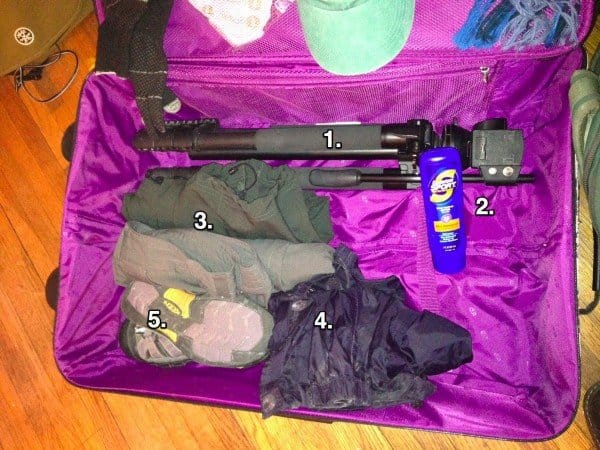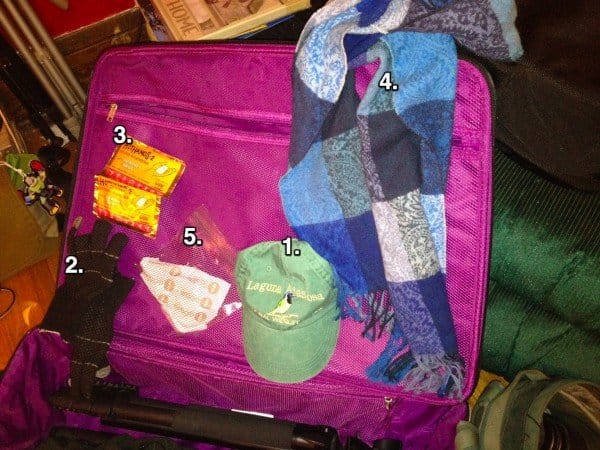I travel for birding. A lot. I’m about to head out to the Hula Valley Bird Festival and as I’m packing, I thought I would share with you some essentials I think any birder should plan to have in their suitcase–no matter where they are visiting. I’ve never regretted any of these items being in my suitcase. I’ve also learned a thing or two from optics reps on how to pack expensive binoculars, spotting scopes and cameras.
First of all–and I want you to burn this into your brain–NEVER put your optics in checked luggage. Don’t. It’s far too easy for optics to go missing and no matter how well you packed them into your suitcase, if airport security decides to go through your checked luggage (and no one ends up stealing your binoculars) they will most likely not repack your optics securely leading to a higher probability that they could be knocked out of alignment. I like to use backpacks as my carry on. I have a backpack from Swarovski but there are a variety of backpacks out there that will do the trick. My carry on will always have my scope (1.) binoculars (2.), camera, laptop, book and a snack. It is always in my person, I know how to gently deal with my backpack and it fits under the seat in front of me.
The suitcase is filled with all sorts of clothing but you have to be prepared for weather extremes.
1.Tripods are generally safe in checked luggage. To help secure it, I will wedge clothing all around it and stuff socks in the middle of the legs. I can take my tripod apart and it will fit into most carry on luggage, but for overseas trips it will go in my big checked suitcase.
2. You can never have too much sunscreen and nothing ruins a good birding trip like getting crisped out your first day in the field. Sunscreen should be one of the first things you pack.
3. Convertible pants are an essential because weather is never dependable. I actually call mine “adventure pants” because they can go from winter wear to shorts for hot weather with a few unzips. I’ve had several brands over the years and my personal favorite at the moment are Columbia’s convertible pants (they make them in short people sizes ) and they material is quick drying and still incredibly comfortable.
4. A small rain jacket. I’ve had this one for years, I grabbed it on clearance at a Land’s End. It wads up into a tiny bundle and fits easily in suitcases or the bottoms of backpacks, because you never know when the squall is going to pop up. It also is a nice thin layer to add on if the wind is just a hair too nippy and you need a barrier. I have also used it on my bird surveys as a make shift shade when temperatures crept up past 110 degrees Fahrenheit last summer.
5. Some sort of waterproof shoe. I like traveling with Keens because they can take a beating and I can throw them into the washer when I get home. They are meant to be used as water shoes when canoeing but I have found that when worn with wool socks, they can even take temperatures a few degrees below freezing. They have great arch support and toe protection and are great for hiking. The one downside: they make your feet incredibly stinky, but if that’s what I must suffer for foot comfort, so be it.
1. Hats are a must. I remember years ago when one of my sisters came with me on a birding trip to Idaho. Before we set out for the day I suggested she put on a hat, I even packed an extra one. She refused saying that she wasn’t a hat person, they don’t look good on her.
By the end of the day, her scalp where her hair was parted was bright pink. The next morning she was trying to part her hair in a different way to cover her burnt scalp. I handed her the hat, she reluctantly accepted.
2. No matter what time of year, always pack a pair of gloves. Even if your birding trip is June, even if you’re going to be in Central America–always pack a pair of gloves. Sometimes high elevations will catch you off guard, sometimes there’s a record cold snap. Don’t let frigid fingers spoil your fun. I was at a birding festival in North Dakota in June and it was a chilly morning. The woman next to me was grumbling about being cold and I said that is why I always pack a pair. She was a native of Florida and said, “I thought since it was summer it would be warm, even for you people.”
3. Hand Warmers are the best thing to happen to outdoor comfort. You can stuff them in shoes, wedge them in gloves and even if it’s too warm, you can use them to apply heat to sore muscles. A few years ago I planned a winter trip to Florida and a record cold snap and frost hit. The hand warmers in my pocket not only were relief for my fingers but kept my batteries in my camera a little warmer too, extending their life.
*Side note: when that cold snap hit in Florida, birders were hitting the local big box stores to look for gloves and having a tough time finding them. I found easily them, but I knew where to look. I’m going to let you in on a pro tip. When looking for gloves, hand warmers, any kind of out door gear for an unexpected weather issue, look for the big box store that has a hunting section–like a Fleet Farm. Hunting sections will always have gloves, wool socks, bug spray–all sorts of handy tools. They might be in camo colors but they will do the trick.
4. Scarves are another way to add a little warmth on a cold morning. It can also be used to absorb sweat or emergency napkin. Depending on some scarves, they can even be a colorful accessory to dress up your outfit when going from the field to a restaurant.
5. Gentlemen may have a tough time reading this part and may want to avert their eyes, but ladies, how many times have you been caught birding with no bathroom in sight and limited options (side of a highway) or a restroom so disgusting a bush is the cleanest option. There are many devices out there to allow for an easier time and even allow you to stand up. I usually pack a GoGirl because it folds up neatly into a small bag. Word of advice, when you purchase one of these, plan on some practice. There is technique in application and dismount. All it takes is one unfortunate breach to reinforce proper alignment and hand placement to teach you how to use them (and it’s much better to have that lesson in the privacy of your own home rather than out in the field with no change of pants).
I do have to say that when I was traveling to Kazakhstan a few years ago, the GoGirl was an item that ended up missing from my checked luggage. Based on the bathrooms, I could understand why it was so irresistible to whomever took it.
How about you? What are your essentials that you think a birder should pack no matter where they are going?
















Notebook. Pencil. Head net.
LOVE this post, Shaz. This topic deserves a lot of discussion.
I usually leave the GoGirl behind, but always bring a small pocket notebook like a Moleskine. Nothing is better for recording your day list, especially in parts of the world where your phone/handheld computer isn’t that practical. Plus, looking back over years of lists can be a more transporting experience than admiring the stamps on your passport (which you should also pack!)
The netbook craze may have died down, but the one place netbooks beat full laptops is on a plane or in your carry-on. Don’t leave home without it, if only as a way to secure your priceless digital photos.
All the good stuff Sharon;
I have seen many despondant faces in the baggage halls of airports around the world. Airlines will usually try to reunite you with your lost or delayed bag as soon as possible, but in the meantime you are in the shops looking for essentials instead of heading out into the bush.
May I add a toothbrush and a change of underwear to your carry on bag so that losing a checked bag will not be a catastrophic failure and prevent you from starting your itinerary.
Birds of Middle East, I never heard of that before. You made me curious now for a trip to middle east. Thanks for adding to my knowledge.
Oh, Rick, I <3 you so much!
Thanks, Redgannet & Mike! Depending on what kind of phone you have, you can get sim cards after customs at the airport and boom, your smart phone works in most countries. Which most have an audio recorder feature for taking lists too. I'm not much of a lister, but when I have to do it for surveys, I find audio recording very handy.
Birding Binoculars, if all goes well, my next beat post will probably include something about birding in Israel.
Good advice! I would add that your carry-on should always have an extra pair or two of underwear, socks, and one extra shirt. Nothing like having your checked luggage arriving several days after you!
Hats with neck-shaders are nice – they help prevent burning on the back of your neck, act as a convenient spot for applying insect repellent (instead of directly on the skin), and can even provide a bit of a wind break.
Insect repellent. No matter where you go in the world, there is some tiny, buzzing thing that will try to feast upon you.
Definitely bring along a notebook and pencil/pens. They fair much better when dropped in a mud puddle than electronics do.
The one sine qua non is a hat. With proper adjustment of the brim it allows me a 360 degree view.
Bug spray! I could go to Antarctica and find mosquitos there.
Bug juice. And salve for when the bug juice doesn’t work.
I learned the glove lesson on July 5th, 2010 in Newfoundland. Mid-afternoon and it was 38 degrees (or 3 degrees as they were saying in Canada). I ended up stopping in a weird general store type thing that was out on the tundra and bought some hideous white stretchy gloves for $1.00. I still have them – my fondest souvenir from The Rock.
I like earmuffs for super windy days (I get earaches) even when hot. A cute skirt and tee or hippy dress is nice for countries where women dress conservatively. Small post earrings work well. A crushable cowboy hat rolled up in your cowboy boots or shove the extra shoes in them. Waterproof self winding watch. Nose hankies and a bandana, one for runny nose and the other for everything else. Set of 8 hot rollers. Vicks vaporub. Baby shampoo and lotion, bandaids, scissors. Cabana boy….ok, I was only sort of kidding about the Cabana boy! And the rest (no I wasn’t).
Plastic bags. Small plastic bags in which to put all that sunscreen and bug stuff. I’ve had too many plastic bottles explode in my suitcase. Medium plastic bags for those muddy Keens. Large plastic bags for laundry.
So many great tips, including ones in the comments! I was taught the plastic bags thing by a grad student I worked with this past summer, it’s been handy ever since.
The one thing you did forget: tweezers! I will never go birding without them ever again. I’m prone to ticks (I’m tasty, what can I say) and realizing you’re being bitten halfway through a birding trip is not only traumatizing, but I’m mildly allergic to their bites too (super itchy). They’re also great if you go browsing through some thorny bushes or run your hand on a tree/bench/other wooden thing.
What a great, informative post and hard to think of anything to add. Bug juice was the first thing that came to mind but others mentioned that. How about an mp3 player to listen to bird sounds on the plane? In the past, I have carried on a Pelican case with optics, microphone, and digital recorder. Security just loves to go over the case with some metal wand thingie.
Bug juice is a good idea but I’m always hesitant to bring that out of the country and usually purchase on arrival after asking locals what is the best.
Once during security check, the guy was scanning my backpack and paused. He looked at me, looked at the bag for a few more seconds and then said, “Is that a Swarovski?”
I said, “I’m impressed you can recognize it by shape!”
“That’s nice stuff you’re packin’,” he said.
One problem I have encountered is the weight limit most airlines have for carry-on luggage. If you have a laptop, a camera, a tele lens, a wide-angle lens, a scope, and binoculars, you’re usually in the range of 10 or more kilograms (20 pounds), which is too much for many airlines.
On a cold day when you are being still (the coldest way to be) try a Hand Warmer on the back of your neck (you may need a handkerchief between it and your skin).
It’s something about an artery close to the skin back there. But it works.
Hand sanitizer, chapstick, Cliff bars, stainless steel water bottle. Wear Insect off clothes. Clean bins cloth and spray. OTC allergy, analgesics,(one with caffiene) Bonine, cough drops (all in tiny sizes) ski beanie in rain jacket pocket. Micro hi power flashlight. “these are a few of my favorite things…”
I’ve started writing a checklist of EVERYTHING I pack and keeping it in a safe place in my carry-on. This way I can check if anything is missing in my checked luggage on arrival. But, mostly it’s so when I pack to go home, I won’t leave anything behind. It probably sounds ridiculous, how can you forget your bins? Or camera? (And, even though clothing isn’t as important as my optics, I do have my favorite birding shirts and hats.) I’ve found that I’m so tired at the end of a trip, I am highly capable of leaving stuff behind. The checklist is a good…check.
Second the bandannas. I buy them by the dozens and carry a couple all the time in the field. Modern high-tech wick-wear, nylon, and wool are great for bodily comfort in cold, wet conditions, but they are as useful as a football bat for wiping glass dry.
Anti-diarrheal medicine.
Plastic bags in three sizes (sparrow, sharpie, and egret), lens cleaner, mini-medical kit (with tweezers, Advil, Claratin, Benadryl, and bug juice), headlamp, hand sanitizer, and notebook all have a place in my bag.
(I was at an outdoor music festival a few weeks ago. I was sitting there and a homeless woman came by wheeling an overloaded hand cart with garbage bags full of cans. One of the bags broke, and there were cans everywhere! I totally whipped out a garbage bag and handed it to her, much to the puzzlement and delight of my companions. Garbage bags: essential for all your journeys!)
Some great adds to the list in hte comments above. Hat’s very important, but a cap isn’t a hat. You need one with a brim all the way round to protect the face, including ears. Cap as well though, worn under the jacket hood to keep it above your eyes so you can use your bins. As mentioned by others, plastic bags in different sizes – good for smelly socks as well – and put every liquid or gel inside one, including pens. Carry-on weight can be a problem as mentioned by Jochen (some airlines are starting to pay staff who spot oversize/weight bags). Always wear a jacket with big pockets, for that wide angle lens and other stuff, hang bins around neck. I have literally been called on an overweight carry-on (5-7kg is the international norm), taken out my bins and put the around my neck, and my camera in my pocket, then been waved on. Makes no sense, but there you go. Lastly, and this will seem like overkill until the loss happens to you on the second day of your trip, take back-up bins and back-up camera.
Fully second the head lamp and the led torch, as I’ve been to many places where electricity is optional! Other things which comes in handy are a pack of wet wipes, sound playback (ipod + portable, battery powered speaker), extra batteries, battery recharger, and car charger for the batteries.
Hi Sharon, I’m the birdo that asked about your packing for birding at the spot om Magee Marsh where you had your scope focussed on ? I forget, maybe the whip-poor-will? Anyway, thanks I found in here on 10,000 birds. My suggestion for packing: a Bug-off/ex officio bandana. Tied around my neck it converts my shirt to a turtleneck for extra warmth, or more loosely, keeps the mozzies at bay! Love your blog, best birding to you!
Hi Madeline,
I do remember you! I was actually talking to my webmaster about finding a way to permalink it to the site.
Thank you so much for the suggestion of the Bug-off, that’s a very good idea.
Love Birds, always watching them